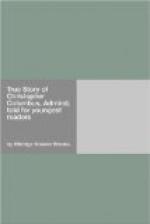I am afraid the king and queen of Spain were beginning to feel a little doubtful as to this still undiscovered Cathay. At any rate, they had other matters to think of and they did not seem so very anxious to spend more money on ships and sailors. But they talked very nicely to Columbus; they gave him a new title (this time it was duke or marquis); they made him a present of a great tract of land in Hayti, but it was months and months before they would help him with the ships and money he kept asking for.
At last, however, the queen, Isabella, who had always had more interest in Columbus and his plans than had the king, her husband, said a good word for him. The six ships were given him, men and supplies were put on board and on the twentieth of May, 1498, the Admiral set out on his third voyage to what every one now called the Indies.
There was not nearly so much excitement among the people about this voyage. Cathay and its riches had almost become an old story; at any rate it was a story that was not altogether believed in. Great crowds did not now follow the Admiral from place to place begging him to take them with him to the Indies. The hundreds of sick, disappointed and angry men who had come home poor when they expected to be rich, and sick when they expected to be strong, had gone through the land, and folks began to think that Cathay was after all only a dream, and that the stories of great gold and of untold riches which they had heard were but “sailors’ yarns” which no one could believe.
So it was hard to get together a crew large enough to man the six vessels that made up the fleet. At last, however, all was ready, and with a company of two hundred men, besides his sailors, Columbus hoisted anchor in the little port of San Lucar just north of Cadiz, near the mouth of the Guadalquivir river, and sailed away into the West.
This time he was determined to find the continent of Asia. Even though, as you remember, he made his men sign a paper saying that the coast of Cuba was Asia, he really seems to have doubted this himself. He felt that he had only found islands. If so, he said, Cathay must be the other side of those islands; and Cathay is what I must find.
So, with this plan in mind, he sent three of his ships to the little settlement of Isabella, and with the other three he sailed more to the southwest. On the first of August the ships came in sight of the three mountain peaks of the large island he called Trindad, or Trinity.
Look on your map of South America and you will see that Trinidad lies almost in the mouth of the Orinoco, a mighty river in the northern part of South America.
Columbus coasted about this island, and as he did so, looking across to the west, he saw what he supposed to be still another island. It was not. It was the coast of South America. For the first time, but without knowing it, Columbus saw the great continent he had so long been hunting for, though he had been seeking it under another name.




